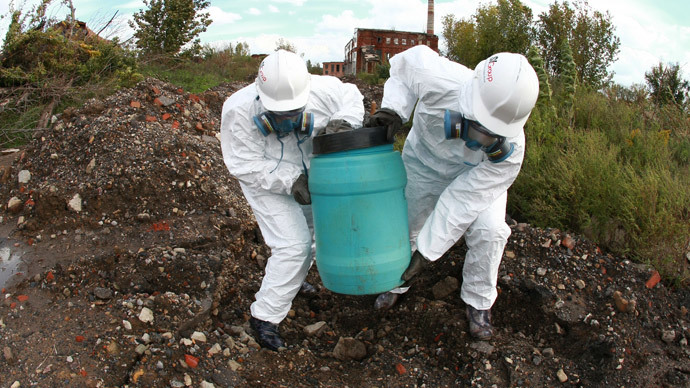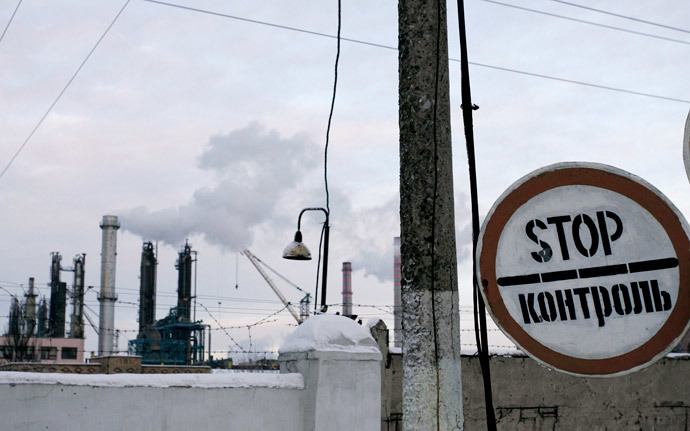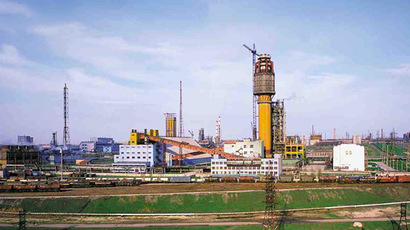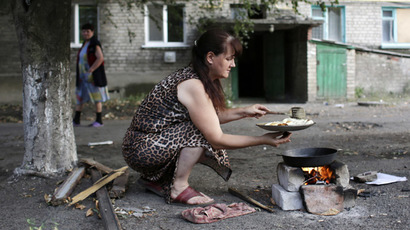3 countries at risk if Kiev shelling leads to Gorlovka chemical leaks – experts

Millions of people will be affected if shelling of the village of Gorlovka by the Ukrainian army leads to leaks at local chemical plants, experts warn, adding that the toxic clouds are also capable of spreading around the world.
A spokesman for Ukraine’s largest chemical plant, Stirol, made
headlines on Monday after releasing a video appeal, in which he
said that “irresponsible actions” by the military, who
are fighting the anti-Kiev rebels in the area, may cause a
massive ecological disaster.
But there’s another large chemical facility in Gorlovka, which is
likely to drastically increase the scale of the catastrophe if
its hit by Ukrainian shells, Viktoria Polyakova, chairman of the
Ukrainian ecological NGO Deko-Vita, told RT’s Russian service.
The removal of hazardous materials from the Gorlovka Sate
Chemical Plant, which is situated just a couple of kilometers
away from the Stirol facilities, has been halted for a long time
now due to military action, she said.
According to Polyakova, the Gorlovka Sate Chemical Plant was in
disastrous condition even before the fighting broke in the
Donetsk Region this spring.
The working lifespan of the protective structures at the plant
has expired long ago and the slightest damage will result in the
release of toxic substances from the storages, she said.
“There are a lot of dangerous substances there: TNT and
sulfates, totaling around 300,000 tons, which are lying around in
the open air. There are also 11,600 types of different poisonous
and highly dangerous substances in the repository and they
pollute the soil. The service life of these storages expired back
in 1998,” the ecologists said.

Millions of people will feel the impact in case of leaks from the
Gorlovka Sate Chemical Plant, Polyakova said.
“It’ll affect not only the whole of Ukraine, but also Russia
and Belarus. This will be a large-scale disaster. Hazardous
substances will inevitably get into the rivers, then the Sea of
Azov and from there to the Black Sea,” she said.
“The rapid spreading of chemicals in hot weather would cause
outbreaks of infectious diseases; lead to exacerbation in cancer
patients; result in damage to the gastrointestinal tract and
mental state of those, who reside in the affected areas,”
she said.
However, the chemicals stored at Stirol plan are even more
dangerous, spokesman Pavel Brykov said in his YouTube video.
The shelling by Ukrainian army may cause a toxic leak of mono
nitrochlorobenzene, also known as “blood poison.”
If this lethal substance enters the human body it violates the
blood formula and destroys neural axis, resulting in death.
Even one milligram of “blood poison” is enough to cause a lethal
effect if it finds its way into the system.

The minimum impact area of a possible disaster at the Stirol
plant would be at least 300 kilometers, Brykov said.
UN chemical safety expert and Moscow State University professor
Valery Petrosyan said that the possible disaster may pose a
threat even for territories outside Russia, Ukraine and Belarus.
The toxic clouds “can make round-the-world trips until the
point until they encounter a rain or snow cloud. After this
happens, they fall on the ground or into the water in the form of
snow or water, respectively,” Petrosyan said.
The risk of chemical leaks is high in Gorlovka, as the Ukrainian
troops are using multiple-rocket launchers, such as Grad and
Uragan, which are deadly but lack precision.
The government began its military operation in the southeast of
Ukraine in mid-April after the people in the Donetsk and Lugansk
regions refused to obey the coup-imposed authorities in Kiev and
demanded autonomy from the central government.
According to UN data, the ongoing fighting between the sides has
already led to more than 1,300 deaths, among both civilians and
troops, and over 4,000 others being wounded.
At the same time, 740,000 Ukrainian refugees have fled to Russia,
with another 118,000 people have being internally displaced.














